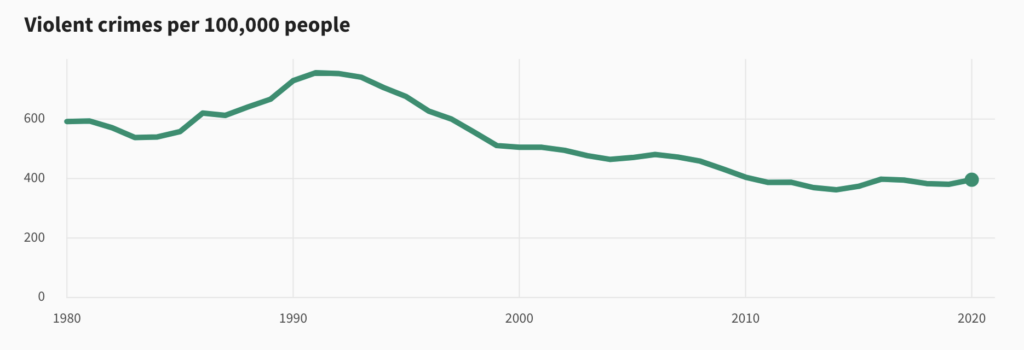Since the inception of this blog, I have been shouting to the heavens to get people to focus not just on consequences for those who commit crimes, but also on the nature of those consequences—the conditions in which we are incarcerated. Since most of us will return to our communities one day, what is value of imprisonment if it doesn’t offer substantial, meaningful rehabilitation? Isn’t it in society’s best interest to receive individuals who are eager and ready to be productive, healthy citizens, rather than those who are more damaged than when they entered?
Tough-on-crime/lock-em-up rhetoric is back in season again as crime is perceived as raging out of control. I say “perceived” because, as The Marshall Project reported, the actual trends lend themselves easily to manipulation. For example, while murders did increase significantly in 2020 and have remained elevated, it’s the least common form of violent crime. Overall, violent crime has remained roughly static since 2010.

But although there has been a steady stream of news reports of abuse and negligence in prison (ranging from rape at federal women’s prisons to homicides and extended solitary confinement at the men’s penitentiary in Thomson, Illinois) there has been little political attention to the conditions of confinement. Sens. Dick Durbin, Jon Ossof and Mike Braun set a promising precedent by introducing the Federal Prison Oversight Act last year, but it wouldn’t do anything to shift the focus of prison from punishment to rehabilitation. The same is generally true at the state level. For example, while Arkansas’ recently introduced “prison reform” bill gives a nod to a pilot program to improve mental health care and re-entry programs, its main focus is more prison beds and longer actual time served.
From notorious abuse to a model for reform
Finally, however, there is a beacon of hope. On March 17, California Gov. Gavin Newsom announced his plan to transform San Quentin State Prison — location of the largest death row in the United States and the notorious home of Black liberation leader George Jackson – into an institution focused on improving public safety through rehabilitation and education. I love that it will be renamed “San Quentin Rehabilitation Center,” but what is more important is the actions that will back up such language. (The walls of the family waiting room at my prison are decorated with optimistic slogans like “dignity” and “respect,” yet we rarely see that practiced among staff.) The death row unit will be shut down (Newsom has declared a moratorium on capital punishment, with those sentenced to it moved to other institutions) and a warehouse will be converted into a “center for innovation focused on education, rehabilitation and breaking cycles of crime.”
The proposal has already been funded to the tune of $20 million, and an advisory group has been named, composed of experts in criminal justice, rehabilitation and public safety experts from around the state, nation and world—as well as both crime victims/survivors and formerly incarcerated individuals. Now, that’s what’s up.
Rehabilitation works
Newsom said he hopes the new center will serve as a model for the nation, and so do I. I’ve been puzzled about why such a model has been so slow in coming. After all, data clearly show that rehabilitation leads to lower recidivism. According to a 2014 Rand report, prisoners who participate in educational programs are 43% less likely to return to prison than those who don’t. Yet federal penitentiaries are locked down more than half of the year, resulting in very few programming opportunities as prisoners wither away in their cells. Staff equates security with punishment (negative reinforcement) rather than promoting peace through positive rewards. (But that’s not even the approach we use to train dogs. When teaching our pets new behaviors, we don’t kick them; we reward them with treats.) That orientation makes these gulags way more volatile than they need to or should be, simply because there is nothing constructive and desirable for prisoners to do.
Many of the men around me need a nudge. Coming from dysfunctional families and neighborhoods, they aren’t equipped to self-rehabilitate.
There are two types of prisoners: those who have the drive and intrinsic characteristics/tools needed to rehabilitate themselves, no matter their conditions of imprisonment, and those who need significant help. The latter far outnumber the former, and that’s the main reason for the high recidivism rate. Here’s how it works: I have a friend who has been locked up for over 30 years, but just earned his GED last year. When people asked him over the years why he didn’t have it, he’d say he didn’t need it because he wasn’t going home anyway. But I knew that response was not all there was to it; deep within, he didn’t feel he was smart enough. Prison staff enforced that self-perception.
But then DC passed the Incarceration Reduction Amendment Act, giving people who had been arrested when they were teens—even those with life sentences—a chance to petition for release (after 15 years of incarceration). He’d now been offered a powerful incentive to better himself. You can’t even imagine how ecstatic he was about his achievement. He asked me dozens of times a day if he’d told me he’d gotten his GED, and I didn’t have the heart to shut him up. Each time, I congratulated him.
Here’s the takeaway: Something else happened in the process of his studying. He gained confidence in himself, believing he could achieve academically. And that can be scaled to working a job or other productive endeavors. Now he is taking college courses and actively preparing for his freedom.
Many of the men around me need that nudge. Coming from dysfunctional families and neighborhoods, they aren’t equipped to self-rehabilitate. If the whole system is geared toward rehabilitation and everyone is working on something positive, then even if a person is “faking it to make it,” he (or she) will more than likely discover that not only can they achieve something, they like it. It is literally life-changing.
Conversely, the way we incarcerate today, we are just warehousing, which merely creates “better” criminals. If we want safer prisons and safer communities, we need to actually rehabilitate. Thank you, Gov. Newsom, for bucking the trend and showing the way.




